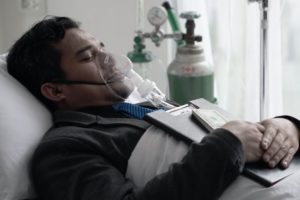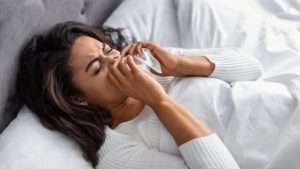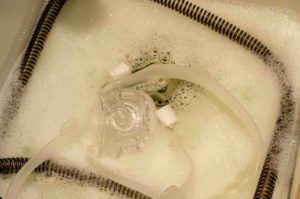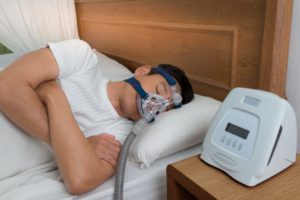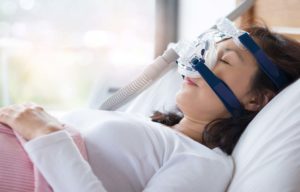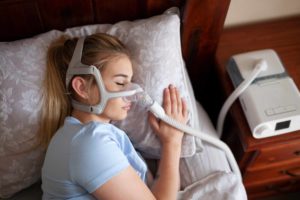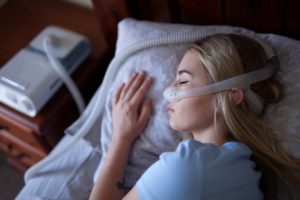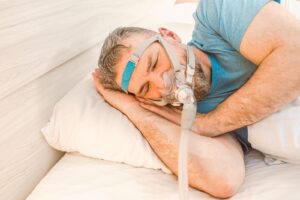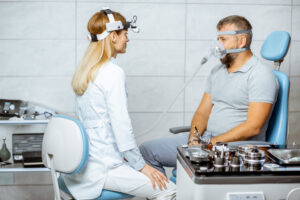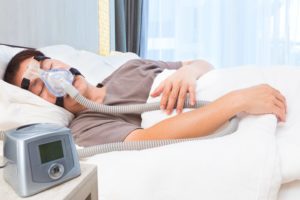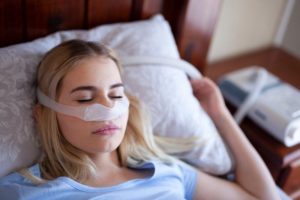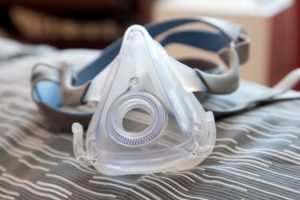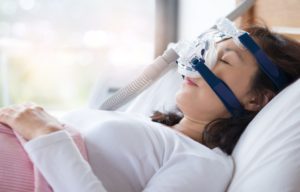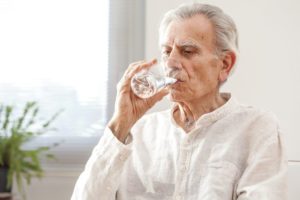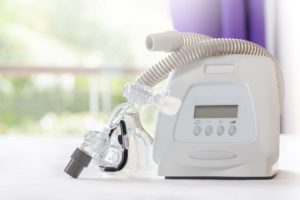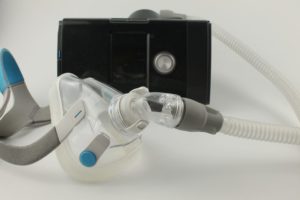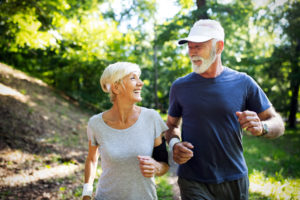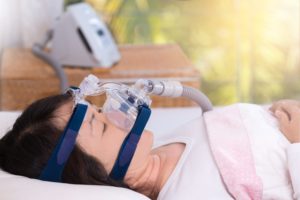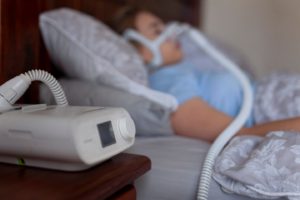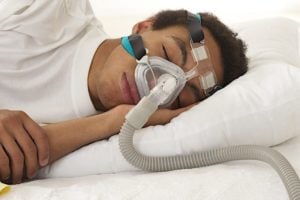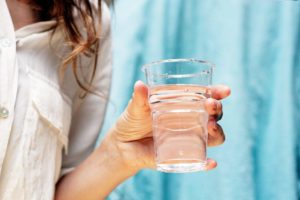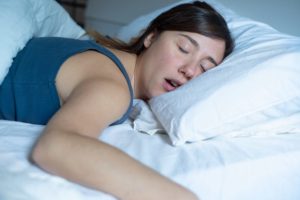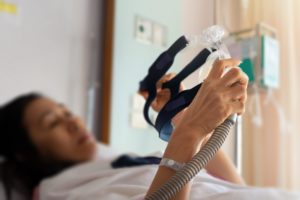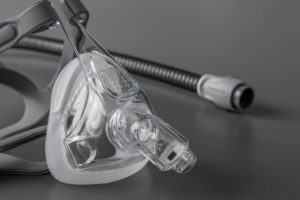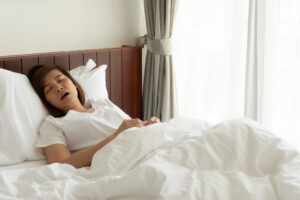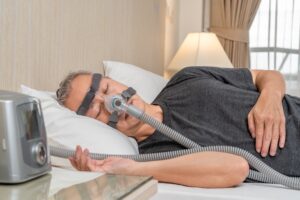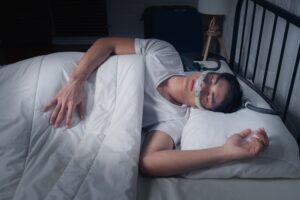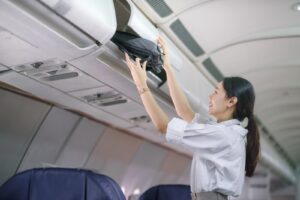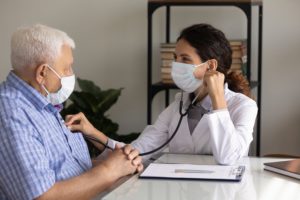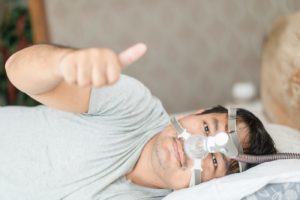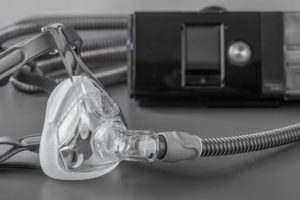When you buy through our links, we may earn a commission. Products or services may be offered by an affiliated entity. Learn more.
EPAP Therapy as a CPAP Alternative
- EPAP therapy helps treat sleep apnea by maintaining open airways during exhalation.
- EPAP helps keep the airway open when the person later exhales without pushing any external air into the airway like CPAP.
- EPAP therapy is an effective, non-invasive treatment for obstructive sleep apnea if CPAP is not suitable.
Up to 9% of people in the U.S. have obstructive sleep apnea (OSA), the most common type of sleep apnea. OSA is characterized by lapses in breathing while asleep. These contribute to fragmented sleep and can result in daytime sleepiness, morning headaches, fatigue, and trouble thinking quickly.
When a person is diagnosed with OSA, their doctor often recommends a device to help keep the airway open during sleep. Although a continuous positive airway pressure (CPAP) machine is commonly recommended, other options include an expiratory positive airway pressure (EPAP) device, a bilevel positive airway pressure (BiPAP) machine, an automatic positive airway pressure (APAP) machine, or an oral appliance. Less commonly, some of these devices may also be used to treat people with central or mixed sleep apnea.
We take a closer look at EPAP therapy, how it differs from CPAP therapy, and how you can decide which sleep apnea treatment is best for you.

Exploring CPAP Machines — But Haven’t Been Tested Yet?
Start with our easy, at-home sleep test. It’s stress-free and effective. Get results within a few days.
What Is an Expiratory Positive Airway Pressure (EPAP) Device?
An EPAP device is considered an emerging therapy for sleep apnea, available as an alternative for people who cannot or do not want to use the standard CPAP therapy. An EPAP is a valve that attaches to the nostrils before sleep. This valve uses only the sleeper’s breath to create pressure as they exhale. This pressure prompts physical changes that make it more likely the airway will remain open during inhalation, reducing the periods of lapsed breathing that characterize sleep apnea. Unlike a CPAP device, an EPAP does not add pressure on inhalation.
In multiple studies, EPAP devices have been demonstrated as a successful treatment for sleep apnea. In one study, EPAP devices significantly reduced the number of times people with OSA stopped breathing during sleep, as well as decreased feelings of daytime sleepiness . A study comparing EPAP and CPAP therapies in people with OSA found no significant difference — both therapies were helpful and safe.
A long-term study of people with OSA found that adherence to EPAP after one year was excellent, provided the therapy was working at the 3-month mark. People using EPAP had fewer breathing cessations, reduced snoring, and less daytime sleepiness.
What Is a Continuous Positive Airway Pressure (CPAP) Machine?
A CPAP machine adds pressure when breathing in and when breathing out. For people with sleep apnea, this pressure keeps the airway from closing as often during the night. To receive air from a CPAP machine, a sleeper must wear a mask that connects their face to the machine via a tube. Some masks cover the mouth and nose, while others cover only the nose or fit into the nose like nose plugs. CPAP machines are considered reliable and effective, but not everyone can tolerate them.
Why Can’t Some People Use CPAP Machines?
Most people can safely use a CPAP machine to treat sleep apnea, but this therapy is not well tolerated in certain circumstances. CPAP therapy is not recommended for people with the following issues :
- Inability to breathe independently
- Reduced consciousness
- Unstable cardiorespiratory status
- Facial burns or trauma
- Surgery on the face, esophagus, or stomach
- Air leak syndrome
- Considerable respiratory secretions
- Strong nausea with vomiting
- Severe air trapping diseases
- Extreme anxiety about using a CPAP machine
Even though CPAP machines are considered the gold standard for treating OSA and work well for most people, not everyone continues using them long-term. In an analysis of studies conducted over 20 years, researchers found that on average, people with OSA only use their CPAP device an average of 4.6 hours per seven-hour sleep period. This is less than the five to six hours of nightly use that are recommended in order for CPAP therapy to be effective. One study found that 10 months after starting CPAP therapy, only about one-third of people continue to use their CPAP machine for an amount that is considered adequate.
People might stop using their CPAP machine for a variety of reasons. Some do not perceive their obstructive sleep apnea as being very serious. Others consider the CPAP mask inconvenient, uncomfortable, claustrophobic, or embarrassing to wear. Sleepers may experience minor side effects, such as a runny nose or nosebleeds, dry mouth, or skin irritation from the mask. Others find that the noise from a CPAP machine disturbs their sleep.
Providing support and education about OSA and CPAP use and ensuring the therapy is available at an affordable price may help improve adherence. However, for people who cannot use a CPAP machine or simply do not want to continue using one, there are other OSA treatment options available.
EPAP vs. CPAP: What Are the Differences Between Therapies?
The primary differences between EPAP and CPAP therapies are in how the devices look and function. A CPAP machine has a motor that pushes filtered air through a tube into the sleeper’s airway, helping keep the airway open throughout the night. To use a CPAP machine, a sleeper must wear a mask that covers their nose or nose and mouth. The entire setup needs to be cleaned regularly, with certain parts replaced every few months. CPAP machines can run on battery power, but most plug into the wall and use electricity.
In comparison to a CPAP machine, an EPAP device is small and light, and it does not require battery power or electricity. Instead, an EPAP device fits in or over the nostrils and contains a valve that naturally creates pressure as a person exhales. This pressure helps keep the airway open when the person later inhales. An EPAP device works because of the sleeper’s own breath and doesn’t involve pushing any external air into the airway, like the CPAP machine does.
Is EPAP As Effective As CPAP?
Further research is needed to determine if an EPAP device is as effective as a CPAP machine when it comes to treating obstructive sleep apnea. Some studies show that the two OSA therapies are equally effective. Other studies, however, suggest that a CPAP machine is more effective .
Even if a CPAP machine is more effective overall, it can only work when it is being used. Initial research shows promising results for EPAP adherence , with some studies finding that people use the EPAP machine 92% of the time. If a person doesn’t adhere to CPAP therapy, using an EPAP device would be more effective than no treatment at all.
Who Is EPAP Better For?
Although EPAP therapy is still considered an alternative treatment for obstructive sleep apnea, an EPAP device could be a better option for people who cannot consistently tolerate using a CPAP machine.
People might be interested in an EPAP device if they want to discontinue using a CPAP machine due to side effects. An EPAP device might also be a better choice for people who travel. Because an EPAP device is much smaller and lighter than a CPAP machine, it is easier to carry. An EPAP device doesn’t require electricity, so it can be easily used while camping or sleeping away from an electrical outlet. A CPAP machine requires routine cleaning and maintenance.
Who Is CPAP Better For?
The efficacy of CPAP therapy for OSA is backed by a large body of scientific research. Most doctors initially prescribe CPAP therapy after diagnosing a person with OSA.
A CPAP machine works best for people with OSA who are able to tolerate the machine. Tolerating the machine well means that a person can fall asleep and stay asleep with their CPAP mask on, without experiencing many negative side effects. Full-face CPAP masks may be more effective than nasal EPAP devices for people who tend to breathe through their mouth.
Although CPAP machines are not as small as EPAP devices, there are portable, battery-operated CPAP machines available that are easier to travel with than standard CPAP machines.
How Do I Decide Which PAP Therapy Is Right for Me?
You can consider an at-home sleep apnea test to determine your best first steps. However, if you have already been diagnosed with obstructive sleep apnea, you should discuss your situation with your doctor or sleep specialist to determine which treatment is best for you. Usually, most doctors recommend people with OSA try a CPAP machine first.
Although CPAP machines require a greater investment up front, they are generally covered at least in part by most insurance plans. Coverage for EPAP devices may be more limited, and in the case of disposable EPAP devices, they may be expensive over the long term.
If you try a CPAP machine and you decide it is not for you, consider asking your doctor if EPAP therapy could be an option. Together, you and your doctor can develop a treatment plan that helps you get the rest you need each night.

Still have questions? Ask our community!
Join our Sleep Care Community — a trusted hub of product specialists, sleep health professionals, and people just like you. Whether you’re searching for the perfect mattress or need expert sleep advice, we’ve got you covered. Get personalized guidance from the experts who know sleep best.
References
11 Sources
-
Strohl, K. P. (2019, March). Merck Manual Consumer Version: Sleep Apnea.
https://www.merckmanuals.com/home/lung-and-airway-disorders/sleep-apnea/sleep-apnea -
Lorenzi-Filho, G., Almeida, F. R., & Strollo, P. J. (2017). Treating OSA: Current and emerging therapies beyond CPAP. Respirology, 22(8), 1500–1507.
https://pubmed.ncbi.nlm.nih.gov/28901030/ -
Berry, R. B., Kryger, M. H., & Massie, C. A. (2011). A novel nasal expiratory positive airway pressure (EPAP) device for the treatment of obstructive sleep apnea: A randomized controlled trial. Sleep, 34(4), 479–485.
https://pubmed.ncbi.nlm.nih.gov/21461326/ -
Liu, Y., Ying, Y., Pandu, J. S., Wang, Y., Dou, S., Li, Y., & Ma, D. (2019). Efficacy and safety assessment of expiratory positive airway pressure (EPAP) mask for OSAHS therapy. Auris, Nasus, Larynx, 46(2), 238–245.
https://pubmed.ncbi.nlm.nih.gov/30262209/ -
Kryger, M. H., Berry, R. B., & Massie, C. A. (2011). Long-term use of a nasal expiratory positive airway pressure (EPAP) device as a treatment for obstructive sleep apnea (OSA). Journal of Clinical Sleep Medicine: Official Publication of the American Academy of Sleep Medicine, 7(5), 449–453B.
https://pubmed.ncbi.nlm.nih.gov/22003339/ -
Pinto, V. L., & Sharma, S. (2021). Continuous positive airway pressure. StatPearls.
https://pubmed.ncbi.nlm.nih.gov/29489216/ -
Rotenberg, B. W., Murariu, D., & Pang, K. P. (2016). Trends in CPAP adherence over twenty years of data collection: A flattened curve. Journal of Otolaryngology – Head & Neck Surgery, 45(1), 43.
https://pubmed.ncbi.nlm.nih.gov/27542595/ -
Broström, A., Arestedt, K. F., Nilsen, P., Strömberg, A., Ulander, M., & Svanborg, E. (2010). The side-effects to CPAP treatment inventory: The development and initial validation of a new tool for the measurement of side-effects to CPAP treatment. Journal of Sleep Research, 19(4), 603–611.
https://pubmed.ncbi.nlm.nih.gov/20408931/ -
Wu, H., Yuan, X., Zhan, X., Li, L., & Wei, Y. (2015). A review of EPAP nasal device therapy for obstructive sleep apnea syndrome. Sleep & Breathing = Schlaf & Atmung, 19(3), 769–774.
https://pubmed.ncbi.nlm.nih.gov/25245174/ -
Walsh, J. K., Griffin, K. S., Forst, E. H., Ahmed, H. H., Eisenstein, R. D., Curry, D. T., Hall-Porter, J. M., & Schweitzer, P. K. (2011). A convenient expiratory positive airway pressure nasal device for the treatment of sleep apnea in patients non-adherent with continuous positive airway pressure. Sleep Medicine, 12(2), 147–152.
https://pubmed.ncbi.nlm.nih.gov/21256800/ -
Iftikhar, I. H., Bittencourt, L., Youngstedt, S. D., Ayas, N., Cistulli, P., Schwab, R., Durkin, M. W., & Magalang, U. J. (2017). Comparative efficacy of CPAP, MADs, exercise-training, and dietary weight loss for sleep apnea: A network meta-analysis. Sleep medicine, 30, 7–14.
https://pubmed.ncbi.nlm.nih.gov/28215266/


